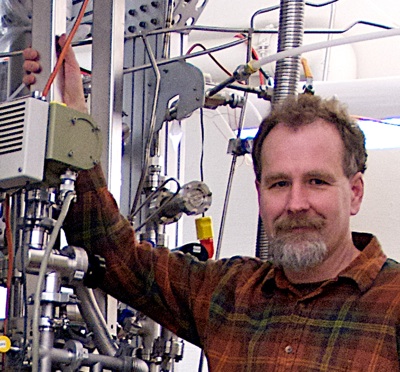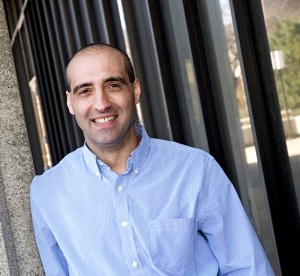Searching for Dark Matter
Physicist Tom Shutt and Colleagues Awarded National Science Foundation Support
By Kevin L. Mayhood
 Tom Shutt is at work on the LUX detector prototype.
Tom Shutt is at work on the LUX detector prototype.
Photos: Daniel Milner
A team of researchers led by physicist Tom Shutt has received a $3.2 million grant from the National Science Foundation to design the world's largest, most sensitive experiment to detect dark matter.
"Some 30 percent of the universe is in the form of a dark matter fundamentally different from ordinary matter," says Shutt, the Agnar Pytte Professor of Physics in the College of Arts and Sciences. For decades, physicists have recognized that dark matter exists; without it, galaxies would lack the mass to form, cluster and rotate as they do. But at this point, no one has ascertained anything more about it. As Shutt observes, "We know there's dark matter; we just don't know what it is."
One of the most promising ideas suggests that dark matter consists of Weakly Interacting Massive Particles (WIMPs). These particles could have been formed in the Big Bang that gave rise to the universe. They are hard to detect because they don't give off radiation. They don't interact with regular matter but pass through it unimpeded, scientists believe.
Shutt's research group, which recently merged with a group led by physics department chair Dan Akerib, will design a 20-ton liquid xenon detector (LZD) to find WIMPs. The group proposed LZD as the flagship experiment for the Deep Underground Science and Engineering Laboratory, a national lab planned for the abandoned Homestake Gold Mine in Lead, South Dakota.
Increasing the Chances
Even before the NSF grant was announced this fall, Shutt was already at work on a related project. With Brown University physicist Rick Gaitskell, he is leading a collaboration of a dozen labs and universities on the Large Underground Experiment (LUX), a 300-kilogram detector that will begin operating next year. LUX will be located in South Dakota's Sanford Underground Science and Engineering Laboratory, also in the former Homestake mine.
Akerib notes that LZD will be 13.5 times larger than LUX and 2,000 times larger than XENON 10, the largest liquid xenon dark matter experiment to date.
Why build bigger? "It's like using a larger light collector in a telescope," Akerib says. "It increases your chances of seeing what you want to see."
Thanks to LZD's greater size, sensitivity and longevity, it will be 150 times more likely than LUX to detect a WIMP. Compared to XENON 10, a 10-kilogram prototype experiment in San Grasso, Italy, it will be 30,000 times more likely to yield results.
Shutt and Akerib say that liquid xenon is the right stuff to catch a WIMP. The element is almost completely inert, unpolarized and hard to polarize. Only dark matter particles can penetrate into the inner region of the xenon liquid without being detected elsewhere, Shutt says.
 Dan Akerib, chair of the physics
department
Dan Akerib, chair of the physics
department
What each experiment looks for is a chance strike: a WIMP knocking into a xenon atom. The collision would produce a minute flash of light that supersensitive detectors would locate, amplify and analyze. In tests, LUX has detected the collision of single neutrons with liquid xenon atoms. LZD would be even more sensitive, by three orders of magnitude, giving the experiment an acuity akin to that required to see an ant in the span of the Milky Way, Akerib says.
When LUX is lowered underground in 2010, the researchers will field test their equipment and master the technology they expect to use in the 20-ton model. Before attempting to build LZD, however, they want an interim step. They are seeking funding for a 1.5-ton detector, which would operate in the same South Dakota lab as LUX.
Avoiding Interference
These experiments are buried deep in the earth for the same reason the Hubble Space Telescope was launched into orbit: to avoid interference. In orbit, Hubble is freed of Earth's obscuring atmosphere. Underground, WIMP experiments are shielded from the hundreds of billions of charged particles that strike the surface of the earth daily, leaving the detector with a clear view should a WIMP strike.
"The discovery of a WIMP would provide evidence for a new state of matter, similar to what an international team is trying to produce at a new collider in Geneva," Akerib says. At the same time, he says, the research "is connected to big philosophical questions: What are we made of? What did we come from?"
The researchers say the technology could lead to a new class of super-sensitive detectors for medicine and global security, including particle detectors that can tell what's happening in a distant nuclear facility and whether a country has or is building nuclear weapons.
In the race to detect WIMPs, the LUX and LZD are competing with other technologies, such as germanium crystals frozen to nearly absolute zero and liquid argon. And the various research groups are all competing for funds to mount bigger experiments.
Masahiro Morii, a physics professor at Harvard University who helped build electronics for LUX, is among a growing number of researchers joining Shutt's project. "Liquid xenon has a distinct advantage: It's straightforward to scale up," Morii says. "It's ahead of the other technologies by three to five years."
Other institutions participating in the liquid xenon program are Lawrence Livermore and Lawrence Berkeley National Laboratories, the University of Maryland, Texas A&M University, the University of California at Davis, the University of Rochester, the University of South Dakota and Yale University. Scientists from the California Institute of Technology, the University of California at Santa Barbara and the South Dakota School of Mines have recently joined the program as well.
In addition, as Shutt and his colleagues look toward building larger detectors, they are collaborating with European scientists from the Imperial College of London; the Moscow Institute for Theoretical and Experimental Physics; the University of Coimbra, Portugal; Rutherford Appleton Laboratories, a United Kingdom national laboratory; and the University of Edinburgh.
